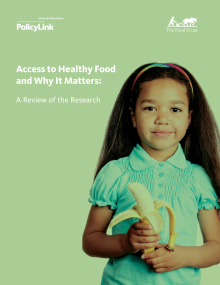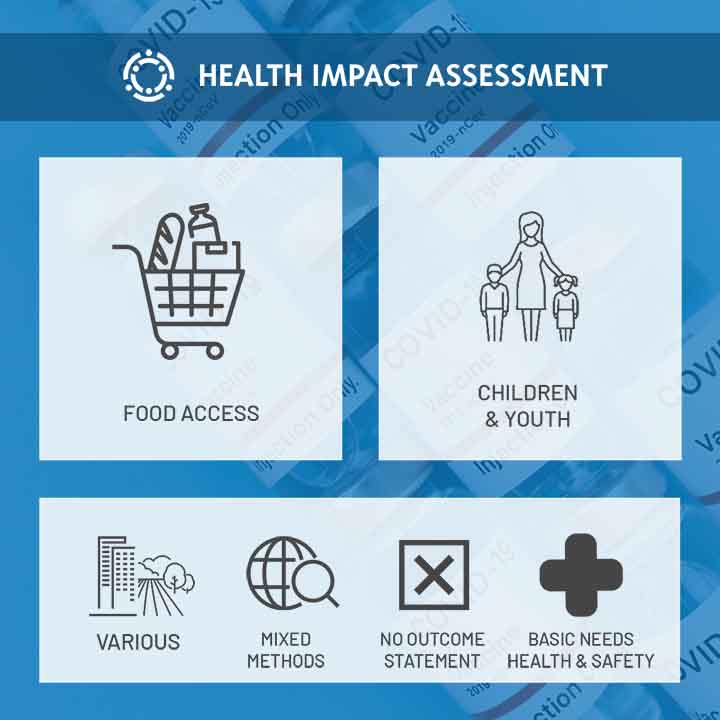Food Access
Everyone deserves access to healthy and affordable foods. Food access refers to a person’s ability to obtain healthy foods, shaped by availability and affordability. Food access plays an integral role in overall food security status, and is an important public health issue, as approximately 1 in 9 people in the United States were food insecure in 2018.
Various factors contribute to disparities in food access. These factors include spatial proximity to healthy food retailers, transportation, and food prices. Food access typically manifests in communities with poor economic indicators, including higher rates of unemployment, poverty, and lower homeownership, as well as in rural communities where transportation and proximity to healthy food is a challenge.
Various programs and policy initiatives can help address food access. For example, community-level responses to food access challenges can include farmers markets, community gardens, CSAs, food rescue agencies, school-based programs, and bringing healthy food retailers to underserved areas to help strengthen local food systems. Initiatives to strengthen federal nutrition programs such as SNAP, WIC, SNAP-Ed, and SNAP incentive programs can also help address food access through large-scale policy.
Resources & Tools
The Impacts of Climate Change on Human Health in the United States: A Scientific Assessment
Resource - Website/webpage
Division Street Gateway
Resource - Assessment
Brought to you by Health Impact Project
Published on 12/31/2011
Mo'omomi Community-Based Subsistence Fishing Area
Resource - Assessment
Brought to you by Health Impact Project
Published on 03/31/2016
Georgia Qualified Allocation Plan for Low-Income Housing Tax Credits
Resource - Assessment
Brought to you by Georgia Health Policy Center
Chukchi Sea Planning Area-Oil and Gas Lease Sale 193 and Seismic Surveying Activities
Resource - Assessment
Brought to you by Health Impact Project
Published on 12/31/2006
East Aldine District's Town Center Development
Resource - Assessment
Brought to you by Health Impact Project
Downtown-Westside Baltimore
Resource - Assessment
Brought to you by Health Impact Project
Published on 05/31/2013
Hamilton Springs Transit-Oriented Development
Resource - Assessment
Brought to you by Health Impact Project
City of Sheridan Comprehensive Plan Update
Resource - Assessment
Brought to you by Health Impact Project
Published on 05/31/2015
Hawai'i County Agriculture Development Plan
Resource - Assessment
Brought to you by Health Impact Project
Planning for Parks, Green Space, and Trails in Greenville's West Side
Resource - Assessment
Brought to you by Health Impact Project
Columbia Transit System Expansion
Resource - Assessment
Brought to you by Health Impact Project
Published on 11/30/2012
Fort McPherson Interim Zoning
Resource - Assessment
Brought to you by Health Impact Project
Published on 12/31/2009
Bright Spot: Corner Store Initiative (Baltimore Health Stores)
Resource - Model Policy
Brought to you by 100MHL
South Billings Master Plan
Resource - Assessment
Brought to you by Health Impact Project
Published on 04/30/2012
Messaging Research: Effective Public Health Communication Strategies for Divisive Political Climate
Resource - Report
Brought to you by BCHC
Street Vendor Legalization and Student Nutrition in South Los Angeles
Resource - Assessment
Brought to you by Health Impact Project
Eugene-Springfield Consolidated Plan and the Impact of Housing on Children's Health
Resource - Assessment
Brought to you by Health Impact Project
Published on 07/31/2014
The Role of Business in Supporting Basic Needs for Health and Safety: Healthy Food
Resource - Policy Brief
Brought to you by WIN Network
Published on 02/25/2021
Macon, Georgia Second Street Redevelopment Plan
Resource - Assessment
Brought to you by Health Impact Project
Published on 09/30/2013
Massachusetts Small Business Technical Assistance Program
Resource - Assessment
Brought to you by Health Impact Project
Published on 01/31/2016
Maricopa County Sodium and Nutrition Standards Procurement Policy
Resource - Assessment
Brought to you by Health Impact Project
Published on 05/31/2012
Proposed Coal Mine at Wishbone Hill
Resource - Assessment
Brought to you by Health Impact Project
Published on 02/29/2012
Ultra-Processed Food Exposure and Adverse Health Outcomes: Umbrella Review of Epidemiological Meta-Analyses
Resource - Report
Brought to you by BMJ
Michigan Street Corridor Plan: A Health Impact Assessment
Resource - Assessment
Brought to you by Health Impact Project
Published on 11/30/2012
City of Independence Complete Streets
Resource - Assessment
Brought to you by Health Impact Project
Published on 12/31/2011
California Senate Bill 622: Sugar-Sweetened Beverage Tax
Resource - Assessment
Brought to you by Health Impact Project
Published on 01/03/2013
Local Laws and Policies That Promote Access To Healthy Food: A Food System Crosswalk
Resource
Brought to you by Healthy Food Policy Project
Knox County Health Department Community Garden
Resource - Assessment
Brought to you by Knox County Health Department
Trinity Plaza Housing Redevelopment
Resource - Assessment
Brought to you by Health Impact Project
Published on 12/31/2004
Coffelt-Lamoreaux Public Housing Redevelopment
Resource - Assessment
Brought to you by Health Impact Project
Published on 10/31/2013
Georgia Qualified Allocation Plan for Low-Income Housing Tax Credits
Resource - Assessment
Brought to you by Health Impact Project
Published on 08/31/2015
North Birmingham Community Framework Plan
Resource - Assessment
Brought to you by School of City and Regional Planning at the Georgia Institute of Technology
Fitchburg Vacant Lots
Resource - Assessment
Brought to you by Health Impact Project
Published on 12/31/2012
Lower South District Plan
Resource - Assessment
Brought to you by Health Impact Project
Published on 02/29/2012
Choice Neighborhood Transformation Plan for a Community in Albany, Georgia
Resource - Assessment
Brought to you by Health Impact Project
Clark County Highway 99 Sub-Area Plan
Resource - Assessment
Brought to you by Health Impact Project
Published on 12/31/2007
Merced County General Plan Update
Resource - Assessment
Brought to you by Health Impact Project
Published on 01/01/2009
Eastern Neighborhoods Community Plans
Resource - Assessment
Brought to you by Health Impact Project
Published on 12/31/2006
Michigan Street Corridor Plan: A Health Impact Assessment
Resource - Assessment
Brought to you by City of Grand Rapids
City of Ramsey Threshold
Resource - Assessment
Brought to you by Health Impact Project
Published on 03/31/2008
Oasis on Ballou Mixed-Use Development
Resource - Assessment
Brought to you by Health Impact Project
Published on 09/27/2012
Globeville and Elyria Swansea Neighborhood Plan HIA
Resource - Assessment
Brought to you by Health Impact Project
Published on 01/01/2014
Red Dog Mine Extension Aqqaluk Project
Resource - Assessment
Brought to you by Health Impact Project
Published on 09/30/2009
Second Street Corridor-Manchester, NH
Resource - Assessment
Brought to you by Health Impact Project
Published on 12/31/2012
South Thornton Revitalization Subarea Plan
Resource - Assessment
Brought to you by Health Impact Project
North Birmingham Community Framework Plan
Resource - Assessment
Brought to you by Health Impact Project
Published on 12/31/2013
The Effects of Wild Rice Water Quality Rule Changes on Tribal Health
Resource - Assessment
Brought to you by Health Impact Project
Published on 09/30/2018
2013 U.S. Farm Bill Reauthorization
Resource - Assessment
Brought to you by Health Impact Project
Published on 12/31/2013
Fresh Foods Market in Central City New Orleans
Resource - Assessment
Brought to you by Health Impact Project
Published on 02/28/2015
Why Place Matters: Building a Movement for Healthy Communities
Resource - Report
Brought to you by PolicyLink
Oregon Farm-to-School Legislation
Resource - Assessment
Brought to you by Health Impact Project
Published on 04/30/2011
George Road Complete Streets Implementation Plan
Resource - Assessment
Brought to you by Health Impact Project
Kings Ridge Apartments
Resource - Assessment
Brought to you by Health Impact Project
Published on 01/01/2012
Fresno County Regional Transportation Plan and Sustainable Communities Strategies
Resource - Assessment
Brought to you by Health Impact Project
Published on 04/30/2014
Long Beach Housing Element
Resource - Assessment
Brought to you by Health Impact Project
Published on 08/01/2013
Building Capacity in HIA on the U.S.-Mexico Border Through Practice, Training, and Collaborative Partnerships
Resource - Assessment
Brought to you by Health Impact Project
Genesee Valley Greenway
Resource - Assessment
Brought to you by Health Impact Project
Published on 05/31/2018
Prevalence and Correlates of Food Insecurity Among U.S. College Students: A Multi-Institutional Study
Resource - Journal Article
School Level Needs Assessment Regulations Under the Every Student Succeeds Act
Resource - Assessment
Brought to you by Health Impact Project
Published on 07/31/2017
Rochester Bike Share
Resource - Assessment
Brought to you by Health Impact Project
Published on 05/31/2018
Knox County Health Department Community Garden
Resource - Assessment
Brought to you by Health Impact Project
Published on 01/01/2010
Food Deserts in Tennessee-HIA of SB 1176
Resource - Assessment
Brought to you by Health Impact Project
Divine Mercy Development
Resource - Assessment
Brought to you by Health Impact Project
Published on 10/31/2011
Fort DuPont Redevelopment Project
Resource - Assessment
Brought to you by Health Impact Project
Published on 05/31/2013
Earned Income Tax Credit in Arkansas
Resource - Assessment
Brought to you by Health Impact Project
Published on 06/30/2019
Metro Westside Subway Extension (Wilshire Corridor)
Resource - Assessment
Brought to you by Health Impact Project
Published on 01/01/2012
Supplemental Nutrition Assistance Program
Resource - Assessment
Brought to you by Health Impact Project
South Los Angeles Fast Food Restaurant Density
Resource - Assessment
Brought to you by Health Impact Project
Published on 06/15/2017
SE 122nd Ave Pilot Project/East Portland
Resource - Assessment
Brought to you by Health Impact Project
Mojave Desert Utility-Scale Solar Project
Resource - Assessment
Brought to you by Health Impact Project
Published on 12/31/2013
Farm to Preschool: The State of the Research Literature and a Snapshot of National Practice
Resource - Journal Article
Published on 10/19/2016
Potential Utility Fee to Fund Columbia Transit
Resource - Assessment
Brought to you by Health Impact Project
Published on 12/31/2012
Clark County Bicycle and Pedestrian Master Plan
Resource - Assessment
Brought to you by Health Impact Project
Farm to School Coordinator in Arkansas
Resource - Assessment
Brought to you by Health Impact Project
Published on 09/30/2017
St. Louis Park Comprehensive Plan
Resource - Assessment
Brought to you by Health Impact Project
Published on 10/31/2011
Portland to Lake Oswego Transit Project
Resource - Assessment
Brought to you by Health Impact Project
Trenton Farmer's Market
Resource - Assessment
Brought to you by Health Impact Project
Published on 12/31/2006
Potential Full-Service Grocery Store Development in a Food Desert
Resource - Assessment
Brought to you by Health Impact Project
Published on 05/31/2013
Kern County Regional Transportation Plan and Sustainable Communities Strategies
Resource - Assessment
Brought to you by Health Impact Project
Cuyahoga County Transportation for Livable Communities Initiative
Resource - Assessment
Brought to you by Health Impact Project
National Nutrition Standards for Snack and a la Carte Foods and Beverages
Resource - Assessment
Brought to you by Health Impact Project
Published on 05/31/2012
Alachua County Transportation Access to Healthy Food Sources
Resource - Assessment
Brought to you by Health Impact Project
Published on 01/09/2013
Mid-Michigan Fair and Affordable Housing Plan
Resource - Assessment
Brought to you by Health Impact Project
Hartford Neighborhood Revitalization and Sustainability Plan
Resource - Assessment
Brought to you by Health Impact Project
The Supplemental Nutrition Assistance Program Recommendations To Support Health and Equity in the Reauthorization of the Farm Bill
Resource - Policy Brief
Brought to you by RWJF
The Grocery Gap: Who Has Access to Healthy Food and Why It Matters
Resource - Report
Brought to you by The Food Trust
Central Park Boulevard Commuter Rail Station-Denver
Resource - Assessment
Brought to you by Health Impact Project
Published on 12/31/2011
Houston Transit-Oriented Development
Resource - Assessment
Brought to you by Health Impact Project
Published on 05/31/2012
Food System Planning in Davidson, North Carolina
Resource - Assessment
Brought to you by Health Impact Project
Published on 10/31/2014
HOPE VI to HOPE SF: San Francisco Public Housing Redevelopment
Resource - Assessment
Brought to you by Health Impact Project
Published on 12/31/2008
San Pablo Corridor
Resource - Assessment
Brought to you by Health Impact Project
Published on 12/31/2008
Wage Theft in Los Angeles
Resource - Assessment
Brought to you by Health Impact Project
Published on 07/01/2014
Access to Affordable and Nutritious Food-Measuring and Understanding Food Deserts and Their Consequences: Report to Congress
Resource - Report
Published on 06/01/2009
Replacing Public Housing Units Destroyed by Hurricane Ike
Resource - Assessment
Brought to you by Health Impact Project
Transit Oriented Development Within Nashville's Northeast Corridor
Resource - Assessment
Brought to you by Health Impact Project
Housing and Urban Development Designated Housing Rule Update
Resource - Assessment
Brought to you by Health Impact Project
Humboldt County General Plan Update
Resource - Assessment
Brought to you by Health Impact Project
Published on 02/29/2008
Baltimore City's Comprehensive Zoning Code Rewrite
Resource - Assessment
Brought to you by Health Impact Project
Published on 01/02/2010
2023 Farm Bill: Advancing Public Health at the Intersection of Food, Environment, and Economic Policy
Story
-
 Original
Original
Brought to you by Community Commons
Indigenous Food Sovereignty Movements Are Taking Back Ancestral Land
Story - Written
Brought to you by Civil Eats
Data Viz: Updates to SNAP and Farmers Market Data
Story
-
 Original
Original
Brought to you by Community Commons
Published on 01/18/2018
What It Takes to Fill a Food Desert
Story - Written
Brought to you by Bloomberg L.P.
Published on 02/08/2024
The Buffalo Shooting Is a Reminder That Millions Don’t Live Near a Grocery Store
Story - Written
Brought to you by NPR
Growth of Organic Farming
Story
-
 Original
Original
Brought to you by Community Commons
Published on 12/29/2016
Uncommon Nonprofit Embraces Urban Agriculture to Break Cycle of Poverty
Story - Written
Brought to you by Seedstock
These Businesses Embrace Their Role in Well-Being
Story
-
 Original
Original
Brought to you by Community Commons
Data & Metrics
Related Topics

















.jpg)














.jpg)



























































































































































.png)







